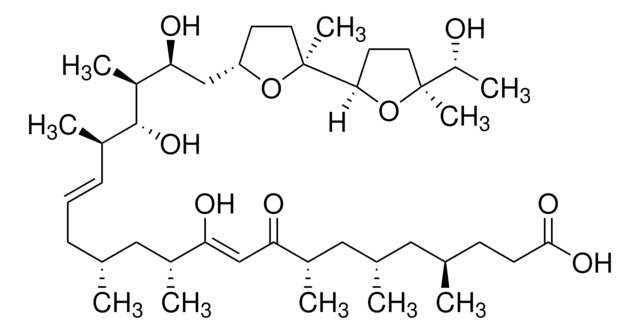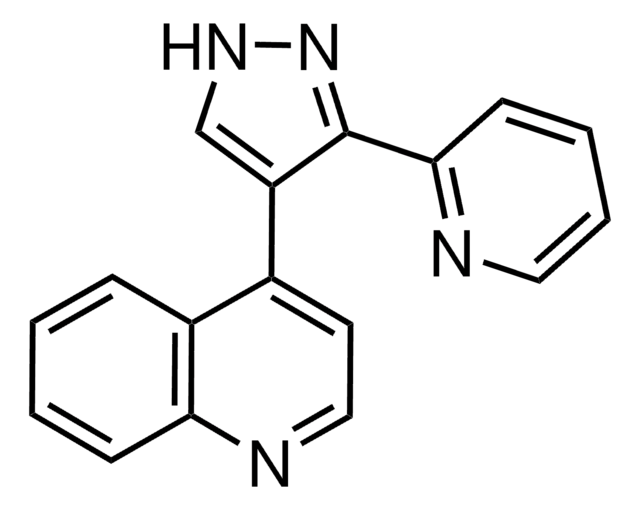5.00582
Phorbol-12-myristate-13-acetate
≥98% (HPLC), liquid, PKC activator, Calbiochem®
Sinónimos:
InSolution Phorbol-12-myristate-13-acetate, 12-O-Tetradecanoyl-phorbol-13-acetate, PMA, TPA
About This Item
Productos recomendados
Nombre del producto
Phorbol-12-myristate-13-acetate, InSolution, ≥98%, 10 mM in DMSO, extremely potent mouse skin tumor promoter
Quality Level
assay
≥98% (HPLC)
form
liquid
manufacturer/tradename
Calbiochem®
storage condition
OK to freeze
avoid repeated freeze/thaw cycles
desiccated (hygroscopic)
protect from light
storage temp.
−70°C
SMILES string
O([C@]21[C@H]([C@H]3[C@@]([C@H]4[C@](CC(=C3)CO)(C(=O)C(=C4)C)O)([C@@H]([C@H]2OC(=O)CCCCCCCCCCCCC)C)O)C1(C)C)C(=O)C
InChI
1S/C36H56O8/c1-7-8-9-10-11-12-13-14-15-16-17-18-29(39)43-32-24(3)35(42)27(30-33(5,6)36(30,32)44-25(4)38)20-26(22-37)21-34(41)28(35)19-23(2)31(34)40/h19-20,24,27-28,30,32,37,41-42H,7-18,21-22H2,1-6H3/t24-,27+,28-,30-,32-,34-,35-,36-/m1/s1
InChI key
PHEDXBVPIONUQT-RGYGYFBISA-N
General description
Biochem/physiol Actions
PKC
Ca2+-ATPase
Packaging
Warning
Reconstitution
Other Notes
Tepper, C.G., et al. 1995. Proc. Natl. Acad. Sci. USA92, 8443.
Oishi, K., and Yamaguchi, M. 1994. J. Cell. Biochem.55, 168.
Macfarlane, D.E., and O′Donnell, P.S. 1993. Leukemia7, 1846.
Ghandi, V.C. and Jones, D.J., 1992. Neuropharmacol.31, 1101.
Hortelano, S., et al. 1992. J. Biol. Chem.267, 24937.
Kontny, E., et al. 1992. Eur. J. Pharmacol.227, 333.
Zanaboni, P.B., et al. 1992. J. Appl. Physiol.73, 2011.
Saltis, J., et al. 1991. J. Biol. Chem.266, 261.
Beguinot, L., et al. 1985. Proc. Natl. Acad. Sci. USA82, 2774.
Perchellet, J. 1985. Carcinogenesis6, 567.
Nishizuka, Y. 1984. Science255, 1365.
Mastro, A. 1982. Lymphokines6, 263.
Legal Information
signalword
Danger
Hazard Classifications
Acute Tox. 3 Dermal - Acute Tox. 3 Inhalation - Carc. 2 - Eye Irrit. 2 - Resp. Sens. 1 - Skin Irrit. 2 - Skin Sens. 1
Storage Class
6.1C - Combustible, acute toxic Cat.3 / toxic compounds or compounds which causing chronic effects
wgk_germany
WGK 2
flash_point_f
188.6 °F - (Dimethylsulfoxide)
flash_point_c
87 °C - (Dimethylsulfoxide)
Certificados de análisis (COA)
Busque Certificados de análisis (COA) introduciendo el número de lote del producto. Los números de lote se encuentran en la etiqueta del producto después de las palabras «Lot» o «Batch»
¿Ya tiene este producto?
Encuentre la documentación para los productos que ha comprado recientemente en la Biblioteca de documentos.
Los clientes también vieron
Nuestro equipo de científicos tiene experiencia en todas las áreas de investigación: Ciencias de la vida, Ciencia de los materiales, Síntesis química, Cromatografía, Analítica y muchas otras.
Póngase en contacto con el Servicio técnico










